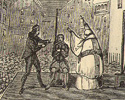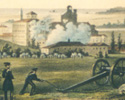19th Century´s militar history in the Basque Country
The British Auxiliary Legion
 Since April 1834, the British fleet controlled the coast of Cantabria to prevent the Carlists from unloading arms. This was one of the agreements made in the Quadruple Alliance, a treaty signed between the Liberal Spanish government and the Liberal powers of Europe, Great Britain, France and Portugal. However, following the military victories of Zumalacárregui, the Madrid government asked its allies to become more involved in the war. Although the British refused to send troops directly, in June 1835, they decided to form a military volunteer corps: the Auxiliary Legion.
Since April 1834, the British fleet controlled the coast of Cantabria to prevent the Carlists from unloading arms. This was one of the agreements made in the Quadruple Alliance, a treaty signed between the Liberal Spanish government and the Liberal powers of Europe, Great Britain, France and Portugal. However, following the military victories of Zumalacárregui, the Madrid government asked its allies to become more involved in the war. Although the British refused to send troops directly, in June 1835, they decided to form a military volunteer corps: the Auxiliary Legion.
The first battalion reached San Sebastián in July of that year and by mid-August, the British Auxiliary Legion with 10,000 men was already in the city. At the end of the month, it took part in an attack on Hernani and suffered its first defeat.
Sir George Lacy Evans was an experienced soldier who was placed in command of the Legion. In response to British involvement in the war, Don Carlos signed the Durango Decree, by which all foreigners fighting with the Liberals would be left out of the Elliot Convention, i.e. they would be shot.
 The Liberal military leader Fernandez de Cordoba decided to station the British Legion at Vitoria, which it reached by December of the same year. However, the winter in the city that year was extremely harsh. By March, over 800 men had died, mainly through illness. Meanwhile, the baker was also arrested for working for the Carlists and condemned to death by cudgel for poisoning the bread of the British.
The Liberal military leader Fernandez de Cordoba decided to station the British Legion at Vitoria, which it reached by December of the same year. However, the winter in the city that year was extremely harsh. By March, over 800 men had died, mainly through illness. Meanwhile, the baker was also arrested for working for the Carlists and condemned to death by cudgel for poisoning the bread of the British.
The Legion returned to San Sebastián in May to fight the Carlists who besieged the city as soon as they arrived. In just a few days, they managed to take the port of Pasajes and build a fort over San Juan, which they named Lord John Hay in honour of the leader of the British fleet on the Cantabrian coast.
 In October, they sent 2,000 members of the Legion to Portugalete to reinforce those raising the siege of Bilbao, and took part in the Battle of Luchana.
In October, they sent 2,000 members of the Legion to Portugalete to reinforce those raising the siege of Bilbao, and took part in the Battle of Luchana.
In March 1837, however, they suffered their greatest defeat in this war at the hands of the Infante Don Sebastian in Oriamendi . Nonetheless, in May, they took advantage of the Royal Expedition to take the towns between San Sebastián and the Bidasoa. They came across their greatest resistance in the town of Irun, which they proceeded to pillage after taking it.
The members of the British Legion had signed up for two years' service and many - including Lacy Evans himself - decided to leave in July 1837, after they had completed their service, because they were always low on provisions and paid very late. However, 1,700 decided to stay under the orders of Colonel O'Conell to form the "New Legion". In September of that year, more than 100 British soldiers lost their lives in Andoain fighting the Carlists under Uranga , which led to the virtual disappearance of the New Legion. In December, O'Conell decided to dissolve the New Legion, blaming the government for his decision because provisions and wages never arrived on time. In figures, it is known that a quarter of the 10,000 men in the British Legion lost their lives in this war. However, half of these 2,500 victims did not die in armed conflict, but through disease.

